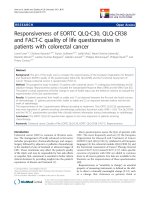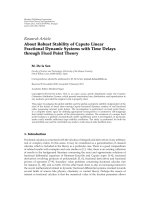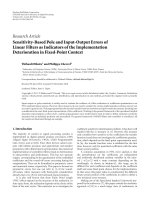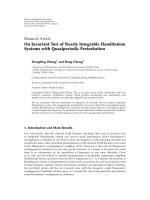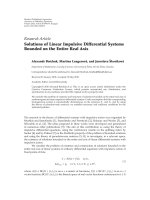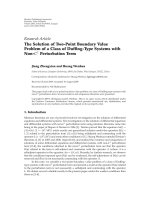Finitetime stabilization and guaranteed cost control of linear autonomous delay systems with bounded controls
Bạn đang xem bản rút gọn của tài liệu. Xem và tải ngay bản đầy đủ của tài liệu tại đây (98.51 KB, 12 trang )
Finite-time stabilization and guaranteed cost
control of linear autonomous delay systems with
bounded controls1
P. NIAMSUPa , V. N. PHATb,∗
a
Department of Mathematics
Chiang Mai University, Chiang Mai 50200, Thailand
b
Institute of Mathematics, VAST
18 Hoang Quoc Viet Road, Hanoi 10307, Vietnam
∗
Corresponding author:
Abstract
For the first time, the finite-time stabilization with guaranteed cost control for linear
autonomous time-varying delay systems with bounded controls is studied in this paper.
Based on the Lyapunov functional method and a generalized Jensen integral inequality,
novel sufficient conditions for designing nonlinear feedback controllers that guarantee the
robust finite-time stabilization of the closed-loop system are established. The obtained
stabilization condition is then adapted to solve the problem of guaranteed cost control.
A numerical example is given to show the effectiveness of the proposed results.
Key words.
Finite-time stabilization, Bounded control, Guaranteed cost control, Timevarying delay, Lyapunov function, Linear matrix inequality.
1
Introduction
In the last decade, we have witnessed an increasing interest to the problem of finite-time
stability and control for linear time-delay systems [1-4]. The finite-time stability (FTS) introduced in [5] means that the state of a system does not exceed some bound during a fixed
interval time. The finite-time stabilization concerns with the design of a feedback controller
which ensures the FTS of the closed-loop system and the problem of guaranteed cost control
(GCC) is to find a feedback controller to finite-time stabilize the system guaranteeing an adequate cost level of performance. Based on linear matrix inequality techniques, some results
have been obtained for FTS and GCC for a class of linear time-delay systems, for instance
[6-10]. However, according to the author’s knowledge, there is no result available yet on FTS
and GCC for linear time-delay systems with bounded controls.
————————————————–
1
This work was completed when the second author was visiting the Vietnam Institute for
Advance Study in Mathematics (VIASM). He would like to thank the VIASM for financial
support and hospitality.
1
The study of stabilizations of systems with control constraints is not only a natural mathematical problem, but also arises often in many applied areas [11-14]. It is clear that control
constraints on the structure of the feedbacks and the neglect of geometric constraints on
the control are hardly in accord with present-day requirements for control systems. Moreover, finite-time stability analysis for linear time-varying delay systems is more difficult,
because time-varying delay systems have more complicated dynamic behaviors than the systems without delay or with constant delays. Furthermore, it is difficult to find an suitable
Lyapunov-Krasovskii functional satisfying the derivative conditions of the FTS and GCC as
shown in [15].
Traditionally, Lyapunov function theory has served as a powerful tool for stability and
control analysis. The idea of a Lyapunov function was extended in [16] in the context of
control design to yield control Lyapunov functions (CLFs). For continuous linear control
systems, there exist a well known method to construct CLFs, which essentially involves
finding a positive definite solution of Riccati equations or linear matrix inequalities (LMIs)
[14, 17-19]. However, the procedures are derived under the assumption of unconstrained
control action. For linear bounded control systems without delays, the system matrix satisfies
some appropriate spectral and controllability properties, papers [20-22] proposed a nonlinear
feedback control to Lyapunov stabilizes the system without delays. It is worth noting that
the approach in these works cannot be applied readily to the systems with time-varying
delays. The main difficulty is that the investigation of the spectrum of the time-varying
delay system matrices is still complicated and there are no appropriate properties available
as in the un-delayed case. Consequently, the problem of the finite-time control of linear
time-delay systems with bounded controls is of interest in its own right.
Motivated by the above discussions, we study the problem of finite-time control for linear
autonomous time-varying delay systems with bounded controls. Our main propose is to
design a nonlinear feedback controller which guarantees the closed-loop system finite-time
stable and guarantees an upper bound on the quadratic cost performance. First, we show
how to obtain sufficient conditions for robust finite-time stabilization of linear autonomous
delay systems with bounded control by using Lyapunov function method and LMI techniques.
Then, we will demonstrate how the obtained stabilization result can be applied to solve the
GCC problem for the system. The conditions are obtained in terms of LMIs, which can be
determined by utilizing MATLABs LMI Control Toolbox [23]. Finally, an example is given
to show the effectiveness of the proposed results.
The structure of the paper is as follows. Section 2 gives the necessary background on
linear time-varying delay systems with bounded controls and some technical lemmas. In
Section 3, the state feedback controller design for robust finite-time stabilization and GCC
is presented together with an illustrative example. Section 4 gives some conclusions.
2
Preliminaries
In this section, we introduce some notations and lemmas. R+ denotes the set of all real
non-negative numbers; Rn denotes the n−dimensional space with the scalar product x⊤ y;
M n×r denotes the space of all matrices of (n × r)−dimensions. A⊤ denotes the transpose
of matrix A; A is symmetric if A = A⊤ ; I denotes the identity matrix; λ(A) denotes the
set of all eigenvalues of A; λmax (A) = max{Reλ; λ ∈ λ(A)}. xt := {x(t + s) : s ∈ [−h, 0]}, ∥
xt ∥= sups∈[−h,0] ∥ x(t + s) ∥; C 1 ([0, t], Rn ) denotes the set of all Rn −valued continuously
2
˙ C } . L2 ([0, t], Rm )
differentiable functions on [0, t] with the norm: ∥φ∥C 1 = max {∥φ∥C , ∥φ∥
m
denotes the set of all the R −valued square integrable functions on [0, t]; Matrix A is called
semi-positive definite (A ≥ 0) if xT Ax ≥ 0, for all x ∈ Rn ; A is positive definite (A > 0)
if x⊤ Ax > 0 for all x ̸= 0; A > B means A − B > 0. The notation diag{. . .} stands for
a block-diagonal matrix. Matrix (Mij )n×m denotes the matrix of Mi,j , i = 1, 2, ..., n, j =
1, 2, ..., m, Mij = Mji , i ̸= j. The symmetric term in a matrix is denoted by ∗.
Consider the following linear autonomous time-varying delay systems with bounded control
{
x(t)
˙
= Ax(t) + Dx(t − h(t)) + Bu(t) + B1 w(t)) t ≥ 0,
(2.1)
x(t) = φ(t), t ∈ [−h2 , 0],
where x(t) ∈ Rn , u(t) ∈ Rm , w ∈ Rr are, respectively, the state, the control, the disturbance
vector, A, D ∈ Rn×n , B ∈ Rn×m , B1 ∈ Rn×p are given constant matrices. The initial function
φ(t) ∈ C 1 ([−h2 , 0], Rn ) . The delay function h(t) is continuous and satisfying
0 ≤ h1 ≤ h(t) ≤ h2 ,
∀t ≥ 0.
(2.2)
The control u ∈ L2 ([0, T ], Rm ) satisfies
∃r > 0 :
||u(t)|| ≤ r,
∀t ≥ 0.
(2.3)
The disturbance w(t) ∈ L2 ([0, T ], Rp ) satisfies
∫ T
∃d > 0 :
w⊤ (t)w(t)dt ≤ d.
(2.4)
0
The performance index associated with the system (2.1) is the following function
∫ T
[x⊤ (t)Q1 x(t) + x⊤ (t − h(t))Q2 x(t − h(t)) + u⊤ (t)Q3 u(t)]dt,
J(u) =
(2.5)
0
where Q1 , Q2 ∈ Rn×n , Q3 ∈ Rm×m , are given symmetric positive definite matrices. The
objective of this paper is to design a feedback controller u(t) = Kx(t) satisfying (2.3) and a
positive number J ∗ such that the resulting closed-loop system
x(t)
˙
= (A + BK)x(t) + Dx(t − h(t)) + B1 w(t),
(2.6)
is finite-time stable for all disturbance w(t) satisfying (2.2) and the value of the cost function
(2.4) is bounded by J ∗ .
Definition 2.1. For given positive numbers T, c1 , c2 , c2 > c1 , and symmetric positive definite
matrix R, the unforced control system (2.1) is robustly finite-time stable w.r.t (c1 , c2 , T, R) if
{
}
sup
φ⊤ (s)Rφ(s) ≤ c1 =⇒ x⊤ (t)Rx(t) < c2 , ∀t ∈ [0, T ],
−h2 ≤s≤0
for all disturbance w(t) satisfying (2.4).
Definition 2.2. If there exist a feedback control law u∗ (t) = Kx(t) satisfying (2.3) and a
positive number J ∗ such that the closed-loop system (2.6) is robustly finite-time stable and
the cost function (2.5) satisfies J(u∗ ) ≤ J ∗ , then the value J ∗ is a guaranteed cost value and
the designed control u∗ (t) is said to be a guaranteed cost controller.
3
We introduce the following technical propositions, which will be used in the proof of our
results.
Proposition 2.1. (Schur complement lemma [24]). Given constant matrices X, Y, Z with
appropriate dimensions satisfying Y = Y ⊤ > 0, X = X ⊤ . Then X + Z ⊤ Y −1 Z < 0 if and
only if
(
)
X Z⊤
< 0.
Z −Y
Proposition 2.2. (Generalized Jensen inequality [25]) For a given symmetric matrix R > 0,
any differentiable function φ : [a, b] → Rn , then the following inequality holds
∫
b
1
12 ⊤
(φ(b) − φ(a))⊤ R(φ(b) − φ(a)) +
Ω RΩ,
b
−
a
b
−a
a
∫ b
φ(b) + φ(a)
1
φ(u)du.
where Ω =
−
2
b−a a
3
φ˙ ⊤ (u)Rφ(u)du
˙
≥
Main result
In this section, Lyapunov function approach is applied in order to design guaranteed cost
controllers for the time-delay system (2.1). The following lemma is necessary for the proof
of main theorem.
⊤
BB P x
Lemma. Let f (x) = −r 1+∥B
T P x∥ , b = ||B||. Then
(i) f (x) is global Lipschitz in Rn .
(ii) ||f (x)|| ≤ 3rb2 ||P x||,
∀x ∈ Rn .
Proof. Let x1 , x2 ∈ Rn and y1 = B ⊤ P x1 , y2 = B ⊤ P x2 . We have
[ y
]
y1
2
∥f (x1 ) − f (x2 )∥ = r B
−
1 + ∥y2 ∥ 1 + ∥y1 ∥
y1
y2
≤ rb
−
1 + ∥y2 ∥ 1 + ∥y1 ∥
∥y2 − y1 ∥ + ∥y1 ∥y2 − ∥y2 ∥y1
≤ rb
.
(1 + ∥y1 ∥)(1 + ∥y2 ∥)
Since
y2 ∥y1 ∥ − y1 ∥y2 ∥ = y2 (∥y1 ∥ − ∥y2 ∥) + ∥y2 ∥(y2 − y1 )
≤ ∥y2 ∥(∥y1 − y2 ∥) + ∥y2 ∥(∥y1 − y2 ∥)
= 2∥y2 ∥(∥y1 − y2 ∥).
and
∥y1 − y2 ∥
≤ ∥y1 − y2 ∥,
(1 + ∥y1 ∥)(1 + ∥y2 ∥)
∥y2 ∥
≤ 1,
(1 + ∥y1 ∥)(1 + ∥y2 ∥)
we have
||f (x1 ) − f (x2 )|| ≤ 3rb||y1 − y2 || ≤ 3rpb2 ||x1 − x2 ||,
4
(3.1)
where p = ||P ||.
(ii) From (3.1) , we have
||f (x1 ) − f (x2 )|| ≤ 3rb||y1 − y2 || = 3rb||B ⊤ P x1 − B ⊤ P x2 ||.
Taking x2 = 0, we have
||f (x)|| ≤ 3rb||B ⊤ P x|| ≤ 3rb2 ||P x||,
∀x ∈ Rn .
Theorem 3.1. If there exist symmetric positive definite matrices P, Si , i = 1, 2, 3, X1 , X2 , a
positive number η > 0 satisfying the following conditions
(Mij )12×12 < 0,
(3.2)
α2 c1 + 2βd
≤ c2 e−ηT ,
α1
(3.3)
then
r
B ⊤ P x(t), t ≥ 0,
(3.4)
1+
is a guaranteed cost controller for the system (2.1) and the guaranteed cost value is given by
u(t) = −
||B ⊤ P x(t)||
J ∗ = α3 ∥φ∥2 + 2βd,
where
P¯ = R−1/2 P R−1/2 , S¯i = R−1/2 Si R−1/2 , i = 1, 2, 3, γ = r2 λmax (Q3 ), α1 = λmin (P¯ ),
{
}
β = λmax (B1⊤ P B1 ) + 2λmax (B1⊤ S4 B1 ), ∥φ∥ = sup
φ⊤ (s)R(s)φ(s), φ˙ ⊤ (s)Rφ(s)
˙
,
−h2 ≤s≤0
α2 = λmax (P¯ ) +
α3 = λmax (P ) +
2
∑
hi λmax (S¯i ) + 0.5.(h2 − h1 )2 (h2 + h1 )λmax (S¯3 ) +
2
∑
i=1
i=1
2
∑
2
∑
hi λmax (Si ) + 0.5.(h2 − h1 )2 (h2 + h1 )λmax (S3 ) +
i=1
M11 = AT P + P A − 4
¯ i ),
0.5h3i λmax (X
0.5h3i λmax (Xi ),
i=1
2
∑
i=1
Xi +
2
∑
Si + P + Q1 , M22 = −S1 − 4S3 − 4X1 ,
i=1
M33 = −S2 − 4S3 − 4X2 , M44 = −8S3 , M55 = (h2 − h1 )2 S3 + h21 X1 + h22 X2 − 2S4 ,
1
M66 = −12X1 , M77 = −12X2 , M88 = M99 = −12S3 , M10,10 = −
I,
1 + 27r2 b4
1
M11,11 = − , M12,12 = −0.5I, M12 = −2X1 , M13 = −2X2 , M14 = P D, M15 = A⊤ S4 ,
γ
M16 = 6X1 , M17 = 6X2 , M18 = M19 = 0, M1,10 = P, M1,11 = P B, M1,12 = 0
M23 = 0, M24 = −2S3 , M25 = 0, M26 = 6X1 , M27 = 0, M28 = 6S3 ,
M29 = M2,10 = M2,11 = M2,12 = 0, M34 = −2S3 , M35 = M36 = 0, M37 = 6X2 ,
M38 = 0, M39 = 6S3 , M3,10 = M3,11 = M3,12 = 0, M45 = DT S4 , M46 = M47 = 0,
M48 = M49 = 6S3 , M4,10 = M4,11 = M4,12 = 0,
M56 = M57 = M58 = M59 = M5,10 = M5,11 = 0, M5,12 = S4 ,
M67 = M68 = M69 = M6,10 = M6,11 = M6,12 = 0,
M78 = M79 = M7,10 = M7,11 = M7,12 = 0, M89 = M8,10 = M8,11 = M8,12 = 0,
M9,10 = M9,11 = M9,12 = M10,11 = M10,12 = 0, M11,12 = 0.
5
Proof. Let us consider the bounded feedback control (3.4). By Lemma (i), the function
BB T P x
f (x) = −r 1+∥B
T P x∥ is global Lipschitz, hence, the closed-loop system
x(t)
˙
= Ax(t) + A1 x(t − h(t)) + B1 w(t) + f (x(t)),
t ∈ R+ ,
(3.5)
has an unique solution. Consider the following Lyapunov-Krasovskii functionals for system
(3.5):
4
∑
Vi (t, xt ),
V (t, xt ) =
i=1
where
ηt ⊤
V1 (t, xt ) =e x (t)P x(t),
∫
V3 (t, xt ) =(h2 − h1 )eηt
V4 (t, xt ) =
2
∑
∫
hi eηt
i=1
We prove that
Since
V2 (t, xt ) =
−h1
∫
−h2
∫
0
−hi
t
2
∑
∫
e
i=1
t
t
ηt
x⊤ (s)Si x(s)ds,
t−hi
x˙ ⊤ (τ )S3 x(τ
˙ )dτ ds
t+s
x(τ
˙ )⊤ Xi x(τ
˙ )dτ ds,
t+s
α1 x⊤ (t)Rx(t) ≤ V (t, xt ), ∀t : 0 ≤ t ≤ T.
(3.6)
V1 (.) = eηt x⊤ P x = eηt x⊤ R1/2 R−1/2 P R−1/2 R1/2 x = eηt xT R1/2 P¯ R1/2 x,
where P¯ = R−1/2 P R−1/2 , we have
V1 (.) = eηt x⊤ R1/2 P¯ R1/2 x ≥ x⊤ R1/2 P¯ R1/2 x ≥ λmin (P¯ )x⊤ Rx,
and α1 = λmin (P¯ ). Similarly, we can verify the following estimations
{
}
V (0, x0 ) ≤ α2 sup
φ⊤ (s)R(s)φ(s), φ˙ ⊤ (s)Rφ(s)
˙
≤ α2 c1 ,
−h2 ≤s≤0
V (0, x0 ) ≤ α3 ∥φ∥2 .
(3.7)
(3.8)
Taking the derivative of V1 (.) we have
V˙1 = ηeηt 2y ⊤ (t)P x(t) + 2eηt x⊤ (t)P x(t)
˙
[
]
= eηt y T (t)[A⊤ P + P A]x(t) + 2x⊤ (t)P Dx(t − h(t)) + 2x⊤ (t)P f (x(t)) + 2xT (t)P B1 w(t)
+ ηV1 (.)
2
[
]
∑
ηt ⊤
˙
V2 = e x (t)(S1 + S2 )x(t) −
x⊤ (t − hi )Si x(t − hi ) + ηV2 (.)
i=1
[
∫
V˙ 3 = eηt (h2 − h1 )2 x⊤(t)S
˙
˙ − (h2 − h1 )
3 x(t)
[
= eηt (h2 − h1 )2 x˙ ⊤ (t)S3 x(t)
˙ − (h2 − h1 )
∫
− (h2 − h1 )
∫
t−h1
t−h2
t−h(t)
t−h2
t−h1
]
x˙ (s)S3 x(s)ds
˙
+ ηV3 (.)
]
x˙ ⊤ (s)S3 x(s)ds
˙
+ ηV3 (.)
t−h(t)
6
⊤
x˙ ⊤ (s)S3 x(s)ds
˙
Applying Proposition 2.2 gives
∫
−(h2 − h1 )
t−h(t)
∫
⊤
x˙ (s)S3 x(s)ds
˙
≤ −(h2 − h(t))
t−h2
t−h(t)
x˙ ⊤ (s)S3 x(s)ds
˙
t−h2
≤ − (x(t − h(t)) − x(t − h2 ))⊤ S3 (x(t − h(t) − x(t − h2 )))
(
)⊤
∫ t−h(t)
x(t − h(t)) + x(t − h2 )
1
− 12
−
x(s)ds
S3
2
h2 − h(t) t−h2
)
(
∫ t−h(t)
1
x(t − h(t)) + x(t − h2 )
−
x(s)ds
2
h2 − h(t) t−h2
≤ − 4xT (t − h(t))S3 x(t − h(t)) − 4x⊤ (t − h2 )S3 x(t − h2 ) − 4x⊤ (t − h(t))U x(t − h2 )
∫ t−h(t)
∫ t−h(t)
12
12
⊤
⊤
+
x (t − h(t))S3
x (t − h2 )S3
x(s)ds +
x(s)ds
h2 − h(t)
h2 − h(t)
t−h2
t−h2
∫ t−h(t)
∫ t−h(t)
12
⊤
x
(s)dsS
x(s)ds.
−
3
(h2 − h(t))2 t−h2
t−h2
and similarly we have
∫
−(h2 − h1 )
t−h1
x˙ T (s)S3 x(s)ds
˙
≤ −4x⊤ (t − h(t))U x(t − h(t)) − 4y ⊤ (t − h1 )S3 x(t − h1 )
t−h(t)
∫ t−h1
12
⊤
x (t − h1 )S3
x(s)ds
− 4x (t − h(t))U x(t − h1 ) +
h(t) − h1
t−h(t)
∫ t−h1
∫ t−h1
∫ t−h1
12
12
⊤
x⊤ (t − h(t))S3
x(s)ds −
+
x
(s)dsS
x(s)ds.
3
h(t) − h1
(h(t) − h1 )2 t−h(t)
t−h(t)
t−h(t)
⊤
Then, we have
[
V˙3 ≤ eηt (h2 − h1 )2 x˙ ⊤ (t)S3 x(t)
˙ − 8y ⊤ (t − h(t))S3 x(t − h(t)) − 4x⊤ (t − h2 )S3 x(t − h2 )
− 4x⊤ (t − h1 )S3 x(t − h1 ) − 4y ⊤ (t − h(t))U x(t − h2 )
∫ t−h(t)
∫ t−h(t)
12
⊤
⊤
x(s)ds
− 4x (t − h(t))S3 x(t − h1 ) −
x (s)dsS3
(h2 − h(t))2 t−h2
t−h2
∫ t−h1
∫ t−h1
12
T
−
x (s)dsS3
x(s)ds + ηV3 (.)
(h(t) − h1 )2 t−h(t)
t−h(t)
∫ t−h(t)
∫ t−h(t)
12
12
T
⊤
x (t − h(t))S3
x(s)ds +
x (t − h2 )S3
y(s)ds
+
h2 − h(t)
h2 − h(t)
t−h2
t−h2
∫ t−h1
∫ t−h1
]
12
12
⊤
⊤
+
x (t − h1 )S3
x(s)ds +
x (t − h(t))S3
x(s)ds .
h(t) − h1
h(t) − h1
t−h(t)
t−h(t)
7
Using the same calculation as in V˙3 (t, xt ), we get
(
V˙4 (t, xt ) ≤ηV4 + eηt x(t)
˙ ⊤ (h21 X1 + h22 X2 )x(t)
˙ + x(t)⊤ (−4X1 − 4X2 )x(t)
− 4x(t − h1 )⊤ X1 x(t − h1 ) − 4x(t − h2 )⊤ X2 x(t − h2 ) − 4x(t)⊤ X1 x(t − h1 )
∫ t
2
∑
12
⊤
⊤
x(t) Xi
− 4x(t) X2 x(t − h2 ) +
x(s)ds
h
t−hi
i=1 i
∫ t
∫
∫ t
2
2
)
∑
∑
12 t
12
⊤
x(s)ds −
x(t − hi )⊤ Xi
+
x(s)
dsX
x(s)ds
.
i
2
hi
h
t−h
t−h
t−h
i
i
i
i
i=1
i=1
Thus, we obtain that
[
V˙ (.) ≤eηt x⊤ (t)[AT P + P A − 4(X1 + X2 )]x(t) + 2x⊤ (t)P Dx(t − h(t)) + 2x⊤ (t)P f (x(t))
+ 2x⊤ (t)P B1 w(t) + x⊤ (t)(S1 + S2 )x(t) −
2
∑
x⊤ (t − hi )Si x(t − hi )
i=1
+ x˙ ⊤ (t)[(h2 − h1 )2 S3 + h21 X1 + h22 X2 )]x(t)
˙ − 8x⊤ (t − h(t))S3 x(t − h(t))
−
2
∑
4x⊤ (t − hi )(S3 + Xi )x(t − hi ) −
i=1
2
∑
4x⊤ (t − h(t))S3 y(t − hi )
i=1
∫ t−h(t)
∫ t−h(t)
12
⊤
x(s)ds
−
4x (t)Xi x(t − hi ) −
x (s)dsS3
(h2 − h(t))2 t−h2
t−h2
i=1
∫ t
∫ t−h1
∫ t−h1
2
∑
12
12
T
+
x(t)⊤ Xi
x(s)ds −
x
(s)dsS
x(s)ds
3
hi
(h(t) − h1 )2 t−h(t)
t−h
t−h(t)
i
i=1
∫ t
∫ t
∫
2
2
)
∑
∑
12 t
12
⊤
⊤
x(s)ds
x(s)ds −
x(s)
dsX
x(t − hi ) Xi
+
i
h
h2
t−hi
t−hi
i=1 i t−hi
i=1 i
2
∑
⊤
∫ t−h(t)
∫ t−h(t)
12
12
⊤
⊤
+
x (t − h(t))S3
x(s)ds +
y (t − h2 )S3
x(s)ds
h2 − h(t)
h2 − h(t)
t−h2
t−h2
∫ t−h1
∫ t−h1
]
12
12
⊤
⊤
+
x (t − h1 )S3
x(s)ds +
x (t − h(t))S3
x(s)ds
h(t) − h1
h(t) − h1
t−h(t)
t−h(t)
(3.9)
+ ηV (t, xt )
Multiplying both sides of equation (3.5) with 4eηt x˙ ⊤ (t)S4 , we obtain
eηt [−4x˙ ⊤ (t)S4 x(t)
˙ + 4x˙ ⊤ (t)S4 Ax(t) + 4x˙ ⊤ (t)S4 Dx(t − h(t))
+ 4x˙ ⊤ (t)S4 B1 w(t) + 4x˙ ⊤ (t)S4 f (x(t))] = 0.
(3.10)
Adding all the zero items of (3.10) and zero term eηt f 0 (t, x(t), x(t−h(t)), u(t))− eηt f 0 (t, x(t),
x(t − h(t)), u(t)) = 0 into (3.9), respectively and using Lemma (ii) and the Cauchy matrix
8
inequality for the following estimations
4x˙ ⊤ (t)S4 B1 w(t) ≤ 2x˙ ⊤ (t)S4 x(t)
˙ + 2w⊤ (t)B1T S4 B1 w(t);
4x˙ ⊤ (t)S4 f (x(t)) ≤ 2x˙ ⊤ (t)S4 S4 x(t)
˙ + 2∥f (x(t))∥2
≤ 2x˙ ⊤ (t)S4 S4 x(t)
˙ + 18r2 b4 x⊤ (t)P P x(t);
2x⊤ (t)P f (x(t)) ≤ x⊤ (t)P P x(t) + ∥f (x(t))∥2 ≤ x⊤ (t)P P x(t) + 9r2 b4 x⊤ (t)P P x(t);
2xT (t)P B1 w(t) ≤ w⊤ (t)B1⊤ P B1 w(t) + x⊤ (t)P x(t),
u⊤ Q3 u(t) ≤ r2 λmax (Q3 )x⊤ P BB T P x(t)
we obtain
V˙ (.) ≤ηV (t, xt ) + eηt ζ ⊤ (t)Vζ(t) − eηt f 0 (t, x(t), x(t − h(t)), u(t)) + eηt βw⊤ (t)w(t)
(3.11)
where β = λmax (B1⊤ P B1 ) + 2λmax (B1⊤ S4 B1 ) and
∫t
∫t
1
⊤ (s)ds, 1
⊤
ζ(t) = [x(t), x(t − h1 ), x(t − h2 ), x(t − h(t)), x(t),
˙
x
h1 t−h1
h2 t−h2 x (s)ds
∫ t−h1
∫ t−h(t)
1
1
⊤
⊤
(h(t)−h1 ) t−h(t) x(s) ds, (h2 −h(t)) t−h2 x(s) ds],
V = (Nij )9×9 , γ = r2 λmax (Q3 ),
N11 = A⊤ P + P A − 4
2
∑
i=1
Xi +
2
∑
Si + P + γP BB ⊤ P + (1 + 27r2 b4 )P P + Q1 ,
i=1
N22 = −S1 − 4S3 − 4X1 , N33 = −S2 − 4S3 − 4X2 , N44 = −8S3 ,
N55 = (h2 − h1 )2 S3 + h21 X1 + h22 X2 − 2S4 + 2S4 S4 ,
N66 = −12X1 , N77 = −12X2 , N88 = N99 = −12S3 , N12 = −2X1 ,
N13 = −2X2 , N14 = P D, N15 = A⊤ S4 , N16 = 6X1 , N17 = 6X2 , N18 = N19 = 0,
N23 = 0, N24 = −2S3 , N25 = 0, N26 = 6X1 , N27 = 0, N28 = 6S3 , N29 = 0,
N34 = −2S3 , N35 = N36 = 0, N37 = 6X2 , N38 = 0, N39 = 6S3 ,
N45 = DT S4 , N46 = N47 = 0, N48 = N49 = 6S3 ,
N56 = N57 = N58 = N59 = 0, N67 = N68 = N69 = 0, N78 = N79 = 0, N89 = 0.
By Proposition 2.2, the conditions V < 0 is equivalent to the condition (2.2). Therefore,
we obtain from (3.11) that
V˙ (t, xt ) < ηV (t, xt ) + 2eηt βw⊤ (t)w(t),
∀t ∈ [0, T ].
(3.12)
Multiplying both sides of (3.12) with e−ηt we have
e−ηt V˙ (t, xt ) − ηe−ηt V (t, xt ) < 2βw⊤ (t)w(t),
Integrating both sides of (3.13) from 0 to t, we obtain
∫ t
e−ηt V (t, xt ) < V (0, x0 ) + 2β
w⊤ (s)w(s)ds,
∀t ∈ [0, T ].
∀t ∈ [0, T ].
0
Therefore, from (3.6), (3.7) it follows that
α1 e−ηt x(t)⊤ Rx(t) < e−ηt V (t, xt ) ≤ α2 c1 + 2βd,
9
(3.13)
and hence
α2 c1 + 2βd ηt
e ≤ c2 , ∀t ∈ [0, T ].
α1
which implies that the closed-loop systems is robustly finite-time stable w.r.t. (c1 , c2 , T, R).
x(t)T Rx(t) <
To find the value of the cost function (2.4), we derive from (3.13) that
e−ηt V˙ (t, xt ) − ηe−ηt V (t, xt ) ≤ −f 0 (t, x(t), x(t − h(t)), u(t)) + 2βw⊤ (t)w(t),
Integrating both sides of (3.14) from 0 to T leads to
∫ T
∫
0
−ηt
f (t, x(t), x(t − h(t)), u(t))dt ≤V (0, x0 ) − e V (t, xt ) + 2β
0
T
t ≥ 0. (3.14)
w⊤ (t)w(t)dt
0
≤V (0, x0 ) + 2βd,
due to V (t, xt ) ≥ 0. Hence, from (3.8), (3.14) it follows that
J ≤ V (0, x0 ) + 2βd ≤ α3 ∥ϕ∥2 + 2βd = J ∗ .
This completes the proof of the theorem.
Remark 3.1. We note that the condition (3.3) is not LMI with respect to η. Since η does not
include in (3.2), we can first find the solutions P, Si , Xi from LMI (3.2) and then determine
η from (3.3).
Example 3.1. Consider the system (2.1) where
[
]
[
]
[
]
[ ]
−2 −0.2
−0.5 −0.5
−0.2
−1
A=
,D=
,B=
, B1 =
0.5 −3
−0.2 0.4
−0.5
−3
{
with
h(t) =
0.1 + 0.4 cos t
0.1
if
if
t ∈ I = ∪k≥0 [2kπ, (2k + 1)π]
t ∈ R+ \ I.
Note that the functions h(t) is non-differentiable. Given
[
]
[
]
[ ]
0.02
0
0.01
0
R = I, Q1 =
, Q2 =
, Q3 = 0.5 .
0
0.01
0
0.05
By using the LMI Toolbox in MATLAB [22], the conditions (3.2) and (3.3) are satisfied with
h1 = 0.1, h2 = 0.5, r = 0.4, r = 0.4, d = 0.01, c1 = 1, c2 = 2.5, T = 10 and η = 0.01,
[
]
[
]
[
]
1.1372 −0.0259
0.4505 −0.0518
0.4013 −0.0512
P =
, S1 =
, S2 =
−0.0259 1.5739
−0.0518 0.8791
−0.0512 0.9069
[
]
[
]
[
]
0.5447 −0.0097
0.2029 −0.0011
1.6168 0.0173
S3 =
, S4 =
, X1 =
,
−0.0097 0.5691
−0.0011 0.1913
0.0173 1.4009
[
]
0.2733 −0.0054
X2 =
.
−0.0054 0.2335
Thus the system is robustly finite-time stable w.r.t. (1, 2.5, 10, I) by feedback controller
u(t) =
0.4(0.2145x1 + 0.7817x2 )
.
1 + (0.2145x1 + 0.7817x2 )
The guaranteed cost valued of the closed-loop system is as follows:
J ∗ = 2.1654∥ϕ∥2 + 0.3797.
10
4
Conclusions
In this paper, the problem of robust finite-time stabilization and guaranteed cost control
for linear time-varying delay systems with bounded controls has been studied. Based on
the Lyapunov functional method and a generalized Jensen integral inequality, new delaydependent delay conditions for the existence of feedback controllers for robust finite-time
stabilization are established. The proposed conditions have been applied to guaranteed cost
control problem. A numerical example is given to illustrate the efficiency of the proposed
method.
Acknowledgments. This work was partially supported by the Chiang Mai University,
Thailand and the the National Foundation for Science and Technology Development, Vietnam
(grant 101.01-2014.35).
References
[1] Garcia G., Tarbouriech S. & Bernussou J. (2009), Finite-time stabilization of linear
time-varying continuous systems. IEEE Trans. Auto. Contr., 54, pp. 364-369.
[2] Amato F., Ambrosino R., Cosentino C. (2010), De Tommasi G., Input-output finite time
stabilization of linear systems. Automatica, 46, 1558-1562.
[3] Liu H., Shena Y. & Zhao X. (2012), Delay-dependent observer-based H∞ finite-time
control for switched systems with time-varying delay. Nonl. Anal.: Hybrid Systems, 6,
885-898.
[4] Zuon Z., Li H. & Wang Y., New criterion for finite-time stability of linear discrete-time
systems with time-varying delay. J. Franklin Institute. 350, 2745-2756 (2013)
[5] Dorato P. (1961), Short time stability in linear time-varying systems. In: Proc IRE Int
Convention Record, 4, 83-87.
[6] Yanga R. & Wang Y. (2013), Finite-time stability analysis and H∞ control for a class
of nonlinear time-delay Hamiltonian systems. Automatica, 49, 390-401.
[7] Hien L.V. (2014), An explicit criterion for finite-time stability of linear nonautonomous
systems with delays. Appl. Math. Lett., 30, 12-18.
[8] Mai, T. V. & Nguyen, T. H. T. (2011) Novel optimal guaranteed cost control of nonlinear systems with mixed multiple time-varying delays. IMA J. Math. Control Inf., 28,
475-486.
[9] Palarkci M.N. (2009), Robust delay-dependent guaranteed cost controller design for uncertain neutral systems. Appl. Math. Comput., 215, 2939-2946.
[10] Park J.H. (2004), Robust non-fragile guaranteed cost control of uncertain large-scale
systems with time-delays in subsystem interconnections. Int. J. Sys. Sci., 35, 233-241.
[11] Thuan M.V., Phat V.N. , Fernando T.L. & H. Trinh (2014), Exponential stabilization
of time-varying delay systems with nonlinear perturbations, IMA J. Contr. Inform. 31,
441-464.
11
[12] Sussman H.J., Sontag E.D. & Yang Y. (1994), A General result on the stabilization of
linear systems using bounded controls. IEEE Trans. Aut. Contr., 39, 2411-2425.
[13] Zhou B. & Duan G.R. (2009), Global stabilization of linear systems via bounded controls.
Syst. Contr. Lett., 58, 54-61.
[14] Moulay E., Dambrine M., Yeganefar N. & Perruquetti W. (2008), Finite-time stability
and stabilization of time-delay systems. Syst. Contr. Lett., 57, 561-566.
[15] Gu K., Kharitonov V.L. & Chen J. (2003), Stability of Time Delay Systems. Boston,
Birkhauser.
[16] Gomes da Silva J.M. & Tarbouriech S. (2001), Local stabilization of discrete-time linear
systems with saturating controls: an LMl-based approach. IEEE Trans. Aut. Contr.,
46, 119-124.
[17] Cai X.S. & Han Z.Z. (2006), Universal construction of control Lyapunov functions for
linear systems. Lat. Am. Appl. Res., 36, 15-22.
[18] Henrion D., Tarbouriech S. & Kucera V. (2005), Control of linear systems subject to
time-domain constraints with polynomial pole placement and LMIs, IEEE Trans. Aut.
Contr., 50, 1360-1363.
[19] Slemrod M. (1989), Feedback stabilization of a linear control system in Hilbert space
with a priori bounded control. Math. Contr. Sig. Sys., 22, 265-285.
[20] Bounit H. & Harmouri H. (1997), Bounded feedback stabilization and global separation
principle of distributed-parameter systems. IEEE Trans. Aut. Contr., 42, 414-419.
[21] Phat V.N. & Niamsup P. (2006), Stabilization of linear nonautonomous systems with
norm-bounded controls. J. Optim. Theory Appl., 131, 135-149.
[22] Gahinet P., Nemirovskii A., Laub A.J. & Chilali M. (1995), LMI Control Toolbox For
use with MATLAB, The MathWorks, Inc.
[23] Boyd S., Ghaoui L.El, Feron E. & Balakrishnan V. (1994), Linear Matrix Inequalities in
System and Control Theory, Philadelphia: SIAM.
[24] Seuret A. & Gouaisbaut F. (2013), Wirtinger-based integral inequality: Application to
time-delay systems. Automatica, 49, 2860-2866.
12


